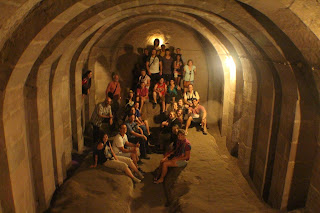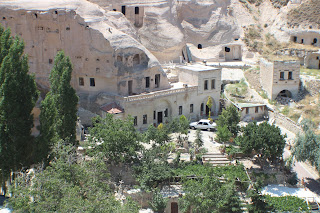Today the day started at 4.00am. It was difficult to get up as its no secret I "don't do mornings"... But the adrenaline kicked in as we arrived at the balloon launch site. The balloons were big! Once they were inflated, we boarded and then very gently took off. As we cleared the little hill, more balloons appeared. By the time we were well in the air, the sky was littered with colourful balloons all reaching for the sky. Apart from the blasts of hot air it was very quiet up in the sky. We reached 5000 feet as the sun rose over the mountainous horizon. It was breath taking. The pilot was a Radji a young Egyptian, who tried to relieve anxiety by cracking not so funny jokes.
After an hour in the air we gently came down not too far from where we took off, as there was hardly any breeze at all. Absolutely perfect morning for a balloon flight. Radji actually managed to land the balloon next to a trailer, then actually lift the balloon by inflating the balloon just enough to float onto the car trailer. "Pretty good," if I may say so...
After the balloon flight we returned to the hotel and had breakfast.
I thought we might get time for a morning nap, since I had to get up so early, but the tour must go on. We boarded our coach for a trip to the local caves. Many of the caves were actual homes, monasteries and churches that people once lived and worshiped in. The churches were very small but with some interesting Byzantine art work. (that we were not allowed to photograph.)
Walking around the churches was hungry work, so naturally the next stop had to be an underground restaurant. Not only was the location impressive but the food was local specialty dish soup, and rice and meat was delicious. The food was cooked in a clay pot for two hours. The top of the pot was sealed with doe. The mix of herbs and spices was like I have never tasted before. I'm sure they have some secret ancient recipe that is kept a top secret. The meal just melted in your mouth.
And there was more... after the lunch we headed off to see some "Fairy chimneys .." Looked more like fairy mushrooms, but who am I to question their description.
Finally we visited a castle, that was also used as a fortress for safety in case of attack from marauding tribes. A great place for a wedding backdrop.
The day ended with opening Sabbath. The topic was Sabbath as an expression of God's Grace...
Another great day!
 |
| The Castle |
 |
| Wedding in front of the Castle |
 |
| Fairy Chimneys |
 |
| Fairy Chimneys |
 |
| Fairy Chimneys |
 |
| The Potter |
 |
| The Potter |
 |
| A platter pattern |
 |
| Blowing up a balloon |
 |
| Blowing up a balloon |
 |
| Blowing up a balloon |
 |
One of the balloons appeared from the
behind the hill. |
 |
| balloons |
 |
| sky full of balloons |
 |
| deflating the balloon on the ground |
 |
| Thank God I'm alive! |
 |
| Art work in the chapel |
 |
| Cave homes and churches |
 |
| The group |
 |
| Stone table in a monestary |
 |
| Wild poppies |
 |
| Walk between the caves |
 |
| Butterfly on a flower |
 |
| Some berries |
 |
| Entrance to the Underground restaurant |
 |
| Underground restaurant |
 |
| Artist painting a vase |
 |
| Artists at work |
















































































